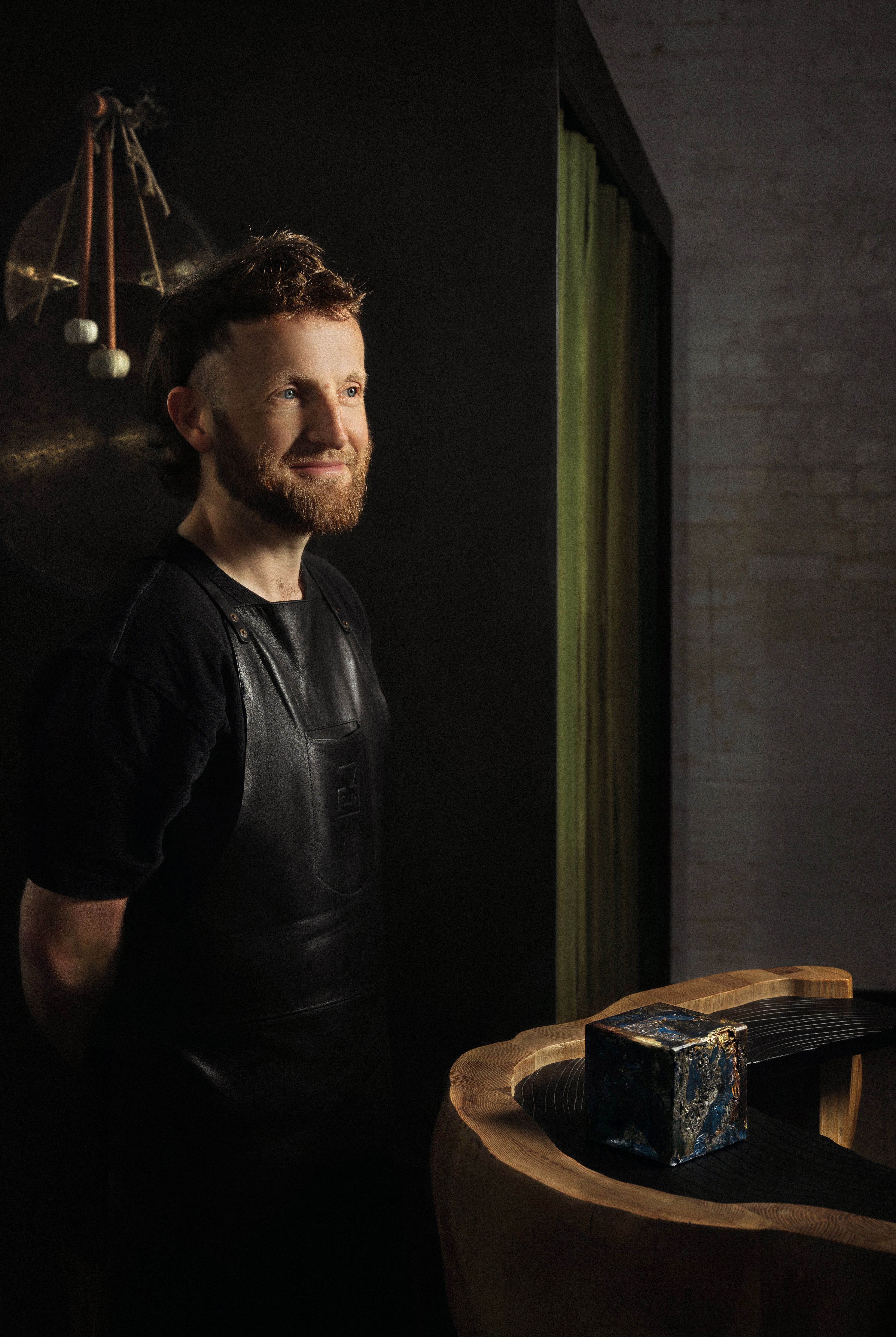"Could you not have a bin in the kitchen," was the catalyst question that sent young chef Doug McMaster on his quest to create the world’s first zero waste restaurant.
It might sound like a lofty claim, but McMaster has dedicated his professional life to zero waste, and wrote The Zero Waste Blueprint so others can follow suit, fastidiously believing this isn’t just a trend. There isn’t a bin in his restaurant, in east London’s Hackney Wick, where we’ve met. Instead, what can’t be used on the menu is composted or fermented and given new life.
It was Joost Bakker, a Dutch-Australian eco-architect who initially proposed the question to McMaster about removing the bin in 2011 while working at popup restaurant The Greenhouse in Sydney, made of waste materials. Humbly, McMaster doesn’t claim to have pioneered the zero waste concept, despite being at the forefront of it in the UK.
When we meet, McMaster’s wearing a black shirt dotted with abstractly-shaped orange, blue, brown and grey and white patches stitched on. It’s upcycled, of course, showing he walks (and wears) the walk, too. On the restaurant bar is a refillable cleaning spray, which reads: "waste is a failure of the imagination". Both the shirt and bottle quickly set the tone for the entire restaurant’s concept, everything in the dining room is made from reclaimed products and regenerative natural materials. The flooring is cork, above is sheepswool in the ceiling, while tables, chairs and plates are made from upcycled plastic and other materials.
"What we’re doing is not a token, or a gesture. It is a holistic approach," he says. It’s not solely about preventing food waste either. McMaster wants to take responsibility for the little waste Silo does produce, such as wine bottles, which are turned into sharing plates and light fittings, using a kiln upstairs at the restaurant, ensuring it’s a self-sufficient process too. While he limits any potential waste that comes in too, by working directly with producers and farmers, meaning they’re able to ensure produce is delivered in reusable vessels or crates, without any single use packaging or plastic.
"Being a zero waste restaurant is in two parts," explains McMaster. "There is the literal system in which we don’t have a general waste bin, which is the distinction that I like the most". The second part is the philosophical side, where he looks to nature and says the restaurant aspires to be more like it. "Nature is a system that doesn’t have a bin and closes the loop on everything… Waste shouldn’t exist, it’s a human thing that we should design out," which is exactly what Silo is working to do.

The way he sees it, is we’re currently divorced and isolated from nature and waste is a symptom of this. "In this industrial landscape, we have this extractive belief that we can just take, take, take from this natural world, and those resources are finite… If we can’t get the right worldview in place, we are doomed."
Though it sounds a dismal outlook, he’s adamant there is hope for the environment. "Nature has this extraordinary ability to bounce back. You can take the most barren landscape and tickle it in the right way and boom, it explodes into diversity and abundance."
When McMaster started Silo, 11 years ago in Brighton (the restaurant later moved to east London in 2019), he says, "people thought I was mad". Though he was on the cusp of the rise in interest in sustainability, food waste, plastic pollution and recycling, which quite quickly went from being on the fringe to mainstream discussions and part of daily life. "Running Silo is not as hard as it was then when we first started, but it still feels like we’re swimming upstream," he adds.
While I’m at the restaurant, Silo’s long-standing forager Andy comes in with his yield. Inside his green canvas backpack is an enormous cluster of mushrooms, which has benefitted from the recent rain and sunshine – a perfect combination for fungus. Inside another bag is a horde of delightfully sour-tasting damsels, chunky dark indigo coloured berries.
They’ll be incorporated in some genius way into Silo’s 12-course set menu, which frequently changes depending on what their producers have available. Though McMaster says there’s "two iconic dishes that almost poetically communicate closed loop cooking," which never leaves the menu.
Zero waste cooking isn’t only about only using odds and ends. Sometimes you will have a dish that is completely virgin
One is the quaver, a snack at the start of the menu. Made from bread waste that’s turned into miso, it’s then deep-fried and becomes a puffed triangular crisp. Then a dark treacle, made from vegetable scraps which has a deep umami flavour, is slathered over it. Lastly, it’s generously topped with grated goats cheese. "It’s a spectacular white cloud. It’s umami, sticky, crunchy, sweet, savoury, it’s absolutely mind blowing," says McMaster. He knows the key to people engaging with and replicating a zero waste model is to make sure the concept is "as beautiful and delicious as everything else on the market," which he certainly succeeds in doing.
The other dish that’s always on the menu is the ice-cream sandwich served at the end, which was derived from the leftover bread and butter course. The wafers are made from bran that comes from milling the flour, and as the team churns their own butter at Silo, they have buttermilk too, which is used to make the ice-cream middle. Though he’s keen to highlight that “zero waste cooking isn’t only about only using odds and ends. Sometimes you will have a dish that is completely virgin”.
Over the last few years, McMaster and team have been trying to find ways to utilise even the hard-to-use food scraps. Until recently, Silo used a very impressive 85 per cent of its produce, composting the remaining 15 per cent. They’ve now managed to increase that to 99 per cent. For context, McMaster explains "a typical fine dining restaurant could waste around 50 per cent of the produce coming in through the door". The key to Silo reaching 99 per cent has been koji, which McMaster explains is "a culture on a starchy substance such as rice or pearled barley, in which we’re growing mold which has long been used in Japan, China and Korea. It has this extraordinary ability to convert food in ways that I can only describe as magical".
"It took us a year or two to truly understand koji and its behaviour. But when we understood it, and did a lot of research using Japanese textbooks, we could then blend koji into all the food waste that we had no other way of processing," he explains.
They’ve had so much success with using koji to convert waste into food, or "liquid gold" as McMaster calls it, that he, along with his head of fermentation Ryan Walker, have created a small ‘fermentation factory’. It’s just a five minute walk from the restaurant, which they’ve named Flux, which means continually changing, pointing to the process’s ability to change the state of natural produce. "We grow koji in abundance here, and it’s how we make koji derived products, such as miso, fish sauce and soy sauce." By using the fermented koji he’s able to give new life to excess that would otherwise have been composted, and enhance Silo’s dishes with intense and fascinating flavours.
Just like when he opened a zero waste restaurant where he was well ahead of the game, McMaster is once again pioneering the future of food through koji. Though other restaurants are using koji, they’re not growing it and using it to the extent Silo is. McMaster is incredibly excited about its future zero waste potential within the food chain and firmly believes "koji is the golden gateway to zero waste".
The Independent will be revealing its Climate100 List on 21 September







